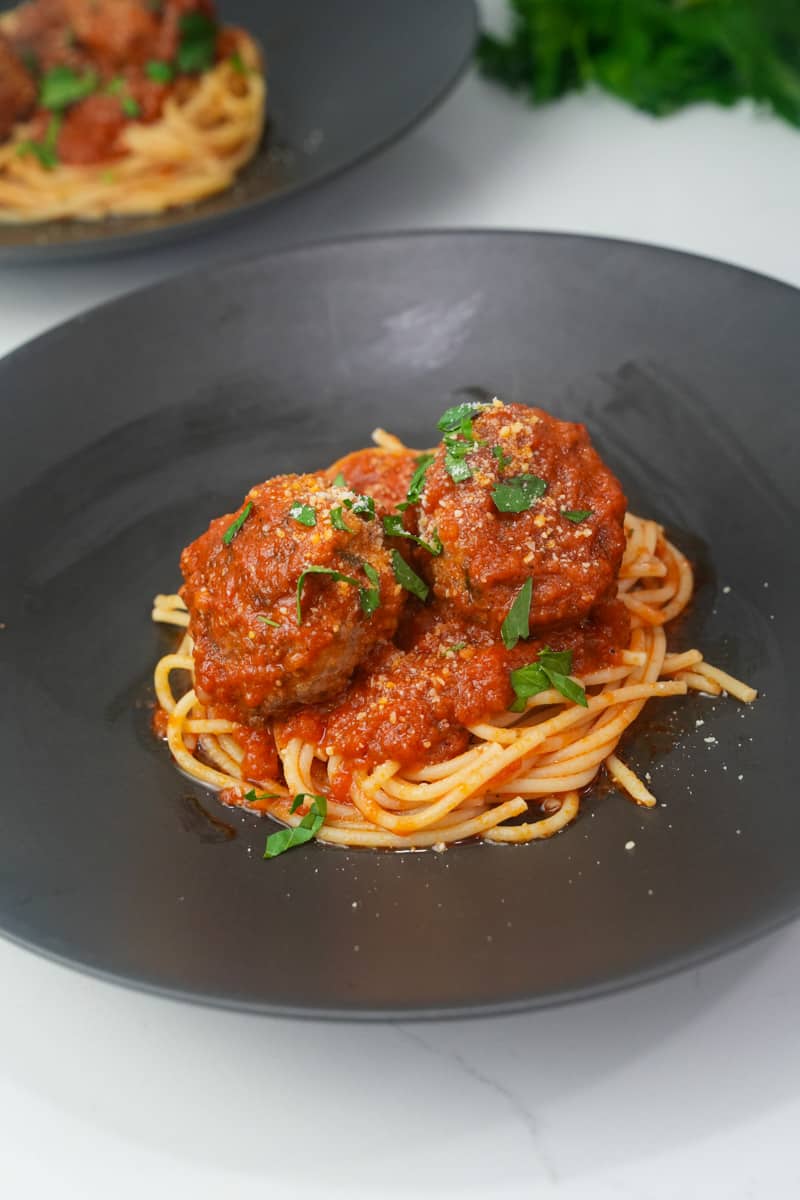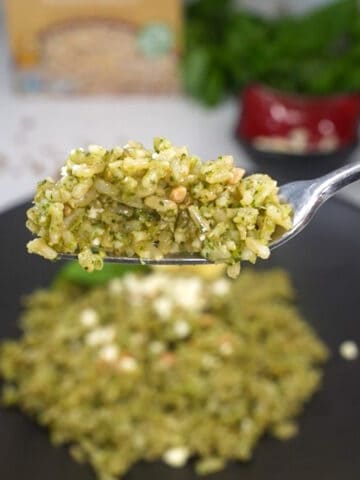Want to make Homemade Spaghetti and Meatballs Recipe? This Spaghetti and Meatballs Recipe is made with ground beef, ground pork, panko crumbs, parmesan, eggs, and parsley!

We're about to embark on a culinary journey to explore one of the most beloved and comforting dishes: spaghetti and meatballs. It's a classic Italian-American favorite that has captured the hearts and appetites of people around the world. From the first bite, the combination of tender meatballs, savory tomato sauce, and perfectly cooked pasta transports us to a place of comfort and satisfaction.
Whether you're cooking for a crowd or simply seeking comfort on a cozy evening, spaghetti and meatballs is a dish that never disappoints. So join us as we unravel the secrets of this timeless classic and embark on a culinary adventure that will leave your taste buds longing for more. Get ready to savor the flavors, embrace the nostalgia, and enjoy the sheer delight that comes with a steaming plate of homemade spaghetti and meatballs. Let's get cooking!
If you love this recipe, feel free to try my Bolognese with Mushroom and Sausage or my Beef Ravioli Sauce.
Jump to:
- What are Spaghetti and Meatballs?
- Why you will love this Homemade Spaghetti and Meatballs Recipe
- Spaghetti and Meatballs Recipe Ingredients
- How to make Homemade Spaghetti and Meatballs
- What to serve with Homemade Spaghetti and Meatballs Recipe
- Substitutions
- Homemade Spaghetti and Meatballs Recipe Variations
- Equipment
- How to store Spaghetti and Meatballs
- Homemade Spaghetti and Meatballs Recipe Top tips
- Homemade Spaghetti and Meatballs Recipe
- Food safety
What are Spaghetti and Meatballs?
Spaghetti and meatballs is a classic Italian-American dish consisting of pasta, meatballs, and tomato sauce. It has become an iconic comfort food enjoyed by people around the world. The dish typically features spaghetti pasta, although other types of pasta like linguine or fettuccine can also be used.
The meatballs are made from ground meat, commonly a combination of beef and pork, seasoned with various herbs, spices, and breadcrumbs. The meat mixture is shaped into balls and cooked until tender and flavorful. The meatballs are then simmered in a rich tomato sauce, which can be made from scratch or using store-bought marinara sauce.

Why you will love this Homemade Spaghetti and Meatballs Recipe
- Comforting and Familiar: Spaghetti and meatballs evoke a sense of comfort and nostalgia. It's a dish that many people grew up with and associate with home-cooked meals and family gatherings. The combination of tender meatballs, savory tomato sauce, and perfectly cooked pasta provides a satisfying and familiar experience.
- Versatile and Customizable: Spaghetti and meatballs offer endless possibilities for customization. You can adjust the flavors of the meatballs by experimenting with different herbs, spices, and types of ground meat. The tomato sauce can also be personalized by adding additional ingredients like garlic, onions, or a splash of wine. Plus, you can choose different types of pasta or even opt for gluten-free or vegetable-based alternatives.
- Hearty and Satisfying: The combination of protein-packed meatballs, carbohydrates from the pasta, and the flavorful tomato sauce makes spaghetti and meatballs a filling and satisfying meal. It provides a balanced combination of nutrients and energy that can keep you satisfied for hours.
- Family-Friendly: Spaghetti and meatballs are a crowd-pleaser, enjoyed by both kids and adults. It's a dish that can bring the whole family together around the dinner table. The simplicity and approachability of the flavors make it a hit with even the pickiest eaters.
Spaghetti and Meatballs Recipe Ingredients
You'll only need a few simple ingredients to make this. The exact measurements are listed in the recipe card below. Here's an overview of what you'll need:
- Ground beef
- Ground pork
- Panko crumbs
- Parmesan
- Eggs
- Parsley
- Garlic
- Olive oil
- Arrabbiatta Sauce or Marinara Sauce
- Red pepper flakes
- Spaghetti
See recipe card for Spaghetti and Meatballs Recipe quantities.
How to make Homemade Spaghetti and Meatballs

Prepare the Meatballs: In a large mixing bowl, combine the ground beef, grated Parmesan cheese, finely chopped parsley, garlic powder, panko breadcrumbs, and egg. Season the mixture with salt and pepper to taste.

Gently mix the ingredients until well combined, but be careful not to overwork the mixture, as it can make the meatballs tough. Shape the mixture into meatballs of your desired size. A golf ball-sized meatball is a common choice.

Cook the Meatballs: Heat a large skillet or frying pan over medium-high heat. Add a bit of olive oil to the pan to prevent sticking. Place the meatballs in the hot pan and cook, turning them occasionally, until they are browned on all sides and browned, about 5 minutes on each side. Lower the heat and pour the sauce over the meatballs. Cover and cook for about 10-15 minutes.

Cook the Spaghetti: In a large pot of salted boiling water, cook the spaghetti according to the package instructions until al dente. Drain the spaghetti and set it aside. Assemble the Dish: Serve the meatballs and sauce over the cooked spaghetti. Garnish with fresh parsley and additional grated Parmesan cheese. Enjoy this Homemade Spaghetti and Meatballs Recipe.
Hint: Brown the meatballs first, remove then add the sauce and return the meatballs.
What to serve with Homemade Spaghetti and Meatballs Recipe
- Garlic Bread: Serve warm garlic bread on the side to soak up the delicious sauce from the spaghetti and meatballs. You can make traditional garlic bread or try variations like cheesy garlic bread or garlic knots.
- Salad: A fresh and crisp salad can provide a refreshing contrast to the richness of the spaghetti and meatballs. Consider a simple green salad with lettuce, tomatoes, cucumbers, and a tangy vinaigrette dressing. Check out my Watermelon Feta Basil Recipe.
- Roasted Vegetables: Roasted vegetables add a savory and nutritious element to the meal. Consider roasting vegetables like zucchini, bell peppers, carrots, or Brussels sprouts with some olive oil, salt, and pepper.
- Caprese Salad: For a fresh and vibrant side, serve a Caprese salad with slices of ripe tomatoes, fresh mozzarella cheese, and basil leaves. Drizzle with balsamic glaze or a simple vinaigrette. Check out my Caprese Crostini Recipe.
- Roasted Potatoes: Roasted potatoes make a hearty and comforting side dish. Cut potatoes into cubes or wedges, toss them with olive oil, herbs, and spices, and roast until crispy and golden.
Substitutions
- Ground beef and ground pork: If you prefer to use different meats, you can substitute the ground beef and pork with ground chicken, turkey, veal, or a combination of any of these.
- Panko crumbs: Regular breadcrumbs or crushed crackers can be used instead of panko crumbs. You can also use gluten-free breadcrumbs if you have dietary restrictions.
- Parmesan: Grated Romano cheese or a similar hard cheese can be used as a substitute for Parmesan.
- Eggs: To bind the meatball mixture, you can use alternatives like flaxseed meal mixed with water (1 tablespoon of flaxseed meal + 3 tablespoons of water per egg) or mashed tofu.
- Parsley: If you don't have parsley, you can use other fresh herbs like basil, oregano, or cilantro, depending on your preference.
- Arrabbiatta Sauce or Marinara Sauce: If you don't have these specific sauces, you can use any tomato-based pasta sauce of your choice, including tomato basil sauce or a homemade tomato sauce.
- Spaghetti: Feel free to use any type of pasta you like, such as linguine, fettuccine, penne, or even gluten-free pasta if needed.

Homemade Spaghetti and Meatballs Recipe Variations
- Italian-style Meatballs: Stick to the classic Italian flavors by adding dried Italian herbs like oregano and basil to the meatball mixture. You can also include a small amount of grated Parmesan or Pecorino cheese for extra richness.
- Mediterranean Twist: Give your meatballs a Mediterranean twist by adding ingredients like chopped sun-dried tomatoes, crumbled feta cheese, and chopped Kalamata olives to the meatball mixture. Serve them with a tangy tzatziki sauce or a lemony Greek yogurt sauce.
- Spicy Kick: If you enjoy a bit of heat, add minced jalapenos or crushed red pepper flakes to the meatball mixture. You can also incorporate a spicy element into the tomato sauce by using a spicy Arrabbiatta sauce or adding diced hot peppers.
- Veggie-loaded Meatballs: For a healthier twist, mix grated zucchini, carrots, or mushrooms into the meatball mixture. These vegetables not only add moisture and flavor but also sneak in some extra nutrients. You can even use plant-based ground meat alternatives for vegetarian or vegan meatballs.
If you are looking for a lighter meal, try my Marry Me Chicken.
Equipment
- Large pot: This is used to cook the spaghetti. Ensure it is big enough to accommodate the pasta and allow for adequate boiling space.
- Mixing bowls: You'll need a couple of mixing bowls to combine the ingredients for the meatballs and the sauce. Choose bowls that are large enough to hold the ingredients and allow for easy mixing.
- Skillet or frying pan: A skillet or frying pan is used to brown the meatballs. Opt for a non-stick skillet or a well-seasoned cast-iron pan for best results.
- Baking sheet (optional): If you prefer to bake the meatballs instead of frying them, you'll need a baking sheet to place the meatballs on. This helps them cook evenly and prevents them from sticking to the pan.
- Slotted spoon or tongs: These utensils are useful for flipping and removing the meatballs from the skillet or baking sheet.
- Pasta strainer or colander: After cooking the spaghetti, you'll need a strainer or colander to drain the pasta and remove excess water.
- Serving dish or plates: Choose a large serving dish or individual plates to present the spaghetti and meatballs when serving.
- Cooking utensils: You'll need a wooden spoon or spatula for mixing the ingredients and stirring the sauce. A whisk can be handy for combining the sauce ingredients. Additionally, a pasta fork or tongs can be useful for serving the cooked spaghetti.
- Grater (optional): If you prefer to grate fresh Parmesan or other cheese as a topping, you'll need a grater to do so.
- Knife and cutting board: These are essential for chopping ingredients such as garlic, parsley, or other herbs.

How to store Spaghetti and Meatballs
To store Spaghetti and Meatballs Recipe properly, follow these guidelines:
- Allow the leftovers to cool: After cooking, let the spaghetti and meatballs cool down to room temperature before storing them. This helps prevent condensation and excess moisture buildup in the container.
- Separate the spaghetti and meatballs: It's best to store the spaghetti and meatballs separately to maintain their texture and prevent the pasta from getting mushy. Place the meatballs in one container and the spaghetti in another.
- Use airtight containers: Transfer the spaghetti and meatballs to separate airtight containers. Airtight containers help maintain freshness, prevent odor transfer, and reduce the risk of contamination. Ensure the containers are suitable for storing food and have secure lids.
- Refrigerate promptly: Place the containers in the refrigerator as soon as possible, ideally within two hours of cooking. Refrigeration slows down bacterial growth and helps keep the food safe to eat. Spaghetti and meatballs can be stored in the refrigerator for up to 3-4 days.
- Freezing option: If you want to store spaghetti and meatballs for a longer period, consider freezing them. Wrap the meatballs and spaghetti individually or place them in separate freezer-safe containers. Label the containers with the date to keep track of their freshness. Frozen spaghetti and meatballs can be stored for up to 2-3 months.
- Thawing and reheating: When you're ready to enjoy your stored spaghetti and meatballs, thaw them in the refrigerator overnight. Reheat the meatballs and sauce in a saucepan over medium-low heat, stirring occasionally until heated through. Heat the spaghetti in boiling water for a few minutes until warmed, then drain. Alternatively, you can reheat individual portions in the microwave.
Homemade Spaghetti and Meatballs Recipe Top tips
- Use a combination of meats: Mixing ground beef with ground pork or veal adds flavor and moisture to the meatballs. The combination of different meats provides a well-rounded taste.
- Soak breadcrumbs in milk: Before adding breadcrumbs to the meatball mixture, soak them in milk for a few minutes. This helps keep the meatballs tender and juicy.
- Don't overmix the meatball mixture: Overmixing can result in tough meatballs. Mix the ingredients just until they are combined to avoid overworking the meat.
- Shape meatballs evenly: To ensure even cooking, make sure your meatballs are all of similar size. Use a cookie scoop or your hands to shape them into uniform balls.
- Brown the meatballs: Before adding the meatballs to the sauce, brown them in a skillet or bake them in the oven. This step adds a flavorful crust and helps retain their shape.
- Simmer meatballs in the sauce: Simmering the meatballs in the sauce allows them to absorb the flavors and ensures they are fully cooked. It also infuses the sauce with the meatball juices, creating a delicious blend of flavors.
- Season the sauce well: Taste the sauce as it simmers and adjust the seasoning accordingly. Don't be afraid to add extra herbs, spices, salt, or pepper to enhance the flavor.
- Cook the spaghetti al dente: When boiling the spaghetti, cook it until it is "al dente," which means it still has a slight bite to it. This prevents the pasta from becoming mushy when combined with the sauce.
- Toss the spaghetti in the sauce: Rather than simply pouring the sauce over the cooked spaghetti, toss the pasta in the sauce in a separate pan or pot. This helps ensure that the sauce evenly coats the spaghetti.
- Garnish with fresh herbs and cheese: Before serving, sprinkle some freshly chopped parsley or basil on top of the spaghetti and meatballs for a pop of freshness. Grate some Parmesan or Pecorino cheese over the dish to add a salty, nutty flavor.

Homemade Spaghetti and Meatballs Recipe
- Total Time: 40 minutes
- Yield: 4 servings 1x
Description
This Spaghetti and Meatballs Recipe is made with ground beef, ground pork, panko crumbs, parmesan, eggs, parsley and cooked to perfection.
Ingredients
- 1 pound ground beef and/or ground pork
- 1 cup panko crumbs
- ½ cup parmesan
- 2 eggs
- ¼ cup fresh parsley
- 2 tablespoons minced garlic
- Salt and pepper
- Light olive oil, for frying
- 1 Jar Arrabbiatta sauce (or your own sauce)
- Red Pepper Flakes for extra spice
- 1 lb spaghetti
Instructions
- Prepare the Meatballs: In a large mixing bowl, combine the beef, grated Parmesan cheese, finely chopped parsley, garlic powder, panko breadcrumbs, and egg. Season the mixture with salt and pepper to taste. Gently mix the ingredients until well combined, but be careful not to overwork the mixture, as it can make the meatballs tough. Shape the mixture into meatballs of your desired size. A golf ball-sized meatball is a common choice.
- Cook the Meatballs: Heat a large skillet or frying pan over medium-high heat. Add a bit of olive oil to the pan to prevent sticking. Place the meatballs in the hot pan and cook, turning them occasionally, until they are browned on all sides and browned, about 5 minutes on each side. Lower the heat and pour the sauce over the meatballs. Cover and cook for about 10-15 minutes.
- Cook the Spaghetti: In a large pot of salted boiling water, cook the spaghetti according to the package instructions until al dente. Drain the spaghetti and set it aside.
- Assemble the Dish: Serve the meatballs and sauce over the cooked spaghetti. Garnish with fresh parsley and additional grated Parmesan cheese.
Notes
- Use a combination of meats: Mixing ground beef with ground pork or veal adds flavor and moisture to the meatballs. The combination of different meats provides a well-rounded taste.
- Soak breadcrumbs in milk: Before adding breadcrumbs to the meatball mixture, soak them in milk for a few minutes. This helps keep the meatballs tender and juicy.
- Don't overmix the meatball mixture: Overmixing can result in tough meatballs. Mix the ingredients just until they are combined to avoid overworking the meat.
- Shape meatballs evenly: To ensure even cooking, make sure your meatballs are all of similar size. Use a cookie scoop or your hands to shape them into uniform balls.
- Brown the meatballs: Before adding the meatballs to the sauce, brown them in a skillet or bake them in the oven. This step adds a flavorful crust and helps retain their shape.
- Simmer meatballs in the sauce: Simmering the meatballs in the sauce allows them to absorb the flavors and ensures they are fully cooked. It also infuses the sauce with the meatball juices, creating a delicious blend of flavors.
- Season the sauce well: Taste the sauce as it simmers and adjust the seasoning accordingly. Don't be afraid to add extra herbs, spices, salt, or pepper to enhance the flavor.
- Cook the spaghetti al dente: When boiling the spaghetti, cook it until it is "al dente," which means it still has a slight bite to it. This prevents the pasta from becoming mushy when combined with the sauce.
- Toss the spaghetti in the sauce: Rather than simply pouring the sauce over the cooked spaghetti, toss the pasta in the sauce in a separate pan or pot. This helps ensure that the sauce evenly coats the spaghetti.
- Garnish with fresh herbs and cheese: Before serving, sprinkle some freshly chopped parsley or basil on top of the spaghetti and meatballs for a pop of freshness. Grate some Parmesan or Pecorino cheese over the dish to add a salty, nutty flavor.
- Prep Time: 10 minutes
- Cook Time: 30 minutes
- Category: Dinner
- Method: Cooking
- Cuisine: Italian
Nutrition
- Serving Size: 1
- Calories: 324.0
- Sugar: 7.7 g
- Sodium: 720.8 mg
- Fat: 7.5 g
- Saturated Fat: 2.4 g
- Carbohydrates: 46.8 g
- Fiber: 3.6 g
- Protein: 18.1 g
- Cholesterol: 49.2 mg
Food safety
- Cook to a minimum temperature of 165 °F (74 °C)
- Do not use the same utensils on cooked food, that previously touched raw meat
- Wash hands after touching raw meat
- Don't leave food sitting out at room temperature for extended periods
- Never leave cooking food unattended
- Use oils with high smoking point to avoid harmful compounds
- Always have good ventilation when using a gas stove








Leave a Reply